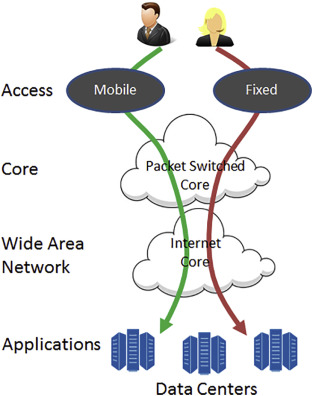当前位置:
X-MOL 学术
›
Environ. Impact Assess. Rev.
›
论文详情
Our official English website, www.x-mol.net, welcomes your
feedback! (Note: you will need to create a separate account there.)
Environmental impact assessment of online advertising
Environmental Impact Assessment Review ( IF 9.8 ) Pub Date : 2018-11-01 , DOI: 10.1016/j.eiar.2018.08.004 M. Pärssinen , M. Kotila , R. Cuevas , A. Phansalkar , J. Manner
Environmental Impact Assessment Review ( IF 9.8 ) Pub Date : 2018-11-01 , DOI: 10.1016/j.eiar.2018.08.004 M. Pärssinen , M. Kotila , R. Cuevas , A. Phansalkar , J. Manner

|
Abstract There are no commonly agreed ways to assess the total energy consumption of the Internet. Estimating the Internet's energy footprint is challenging because of the interconnectedness associated with even seemingly simple aspects of energy consumption. The first contribution of this paper is a common modular and layered framework, which allows researchers to assess both energy consumption and CO2e emissions of any Internet service. The framework allows assessing the energy consumption depending on the research scope and specific system boundaries. Further, the proposed framework allows researchers without domain expertise to make such an assessment by using intermediate results as data sources, while analyzing the related uncertainties. The second contribution is an estimate of the energy consumption and CO2e emissions of online advertising by utilizing our proposed framework. The third contribution is an assessment of the energy consumption of invalid traffic associated with online advertising. The second and third contributions are used to validate the first. The online advertising ecosystem resides in the core of the Internet, and it is the sole source of funding for many online services. Therefore, it is an essential factor in the analysis of the Internet's energy footprint. As a result, in 2016, online advertising consumed 20–282 TWh of energy. In the same year, the total infrastructure consumption ranged from 791 to 1334 TWh. With extrapolated 2016 input factor values without uncertainties, online advertising consumed 106 TWh of energy and the infrastructure 1059 TWh. With the emission factor of 0.5656 kg CO2e/kWh, we calculated the carbon emissions of online advertising, and found it produces 60 Mt CO2e (between 12 and 159 Mt of CO2e when considering uncertainty). The share of fraudulent online advertising traffic was 13.87 Mt of CO2e emissions (between 2.65 and 36.78 Mt of CO2e when considering uncertainty). The global impact of online advertising is multidimensional. Online advertising affects the environment by consuming significant amounts of energy, leading to the production CO2e emissions. Hundreds of billions of ad dollars are exchanged yearly, placing online advertising in a significant role economically. It has become an important and acknowledged component of the online-bound society, largely due to its integration with the Internet and the amount of revenue generated through it.
中文翻译:

网络广告环境影响评价
摘要 目前还没有普遍认可的方法来评估互联网的总能耗。由于与能源消耗的看似简单的方面相关联,因此估算互联网的能源足迹具有挑战性。本文的第一个贡献是一个通用的模块化和分层框架,它允许研究人员评估任何互联网服务的能源消耗和 CO2e 排放。该框架允许根据研究范围和特定系统边界评估能源消耗。此外,所提出的框架允许没有领域专业知识的研究人员通过使用中间结果作为数据源进行此类评估,同时分析相关的不确定性。第二个贡献是利用我们提出的框架估算在线广告的能源消耗和二氧化碳排放量。第三个贡献是评估与在线广告相关的无效流量的能耗。第二个和第三个贡献用于验证第一个。在线广告生态系统位于互联网的核心,它是许多在线服务的唯一资金来源。因此,它是分析互联网能源足迹的重要因素。因此,2016 年,在线广告消耗了 20-282 TWh 的能源。同年,基础设施总消耗量从 791 到 1334 TWh 不等。在没有不确定性的情况下外推 2016 年输入因子值,在线广告消耗了 106 TWh 的能源和 1059 TWh 的基础设施。使用 0.5656 kg CO2e/kWh 的排放因子,我们计算了在线广告的碳排放量,发现它产生 60 Mt CO2e(在考虑不确定性时为 12 到 159 Mt CO2e)。欺诈性在线广告流量的份额占 CO2e 排放量的 13.87 Mt(考虑不确定性时为 2.65 至 36.78 Mt CO2e)。在线广告的全球影响是多方面的。在线广告通过消耗大量能源来影响环境,导致生产二氧化碳排放。每年有数千亿美元的广告交易,使在线广告在经济上发挥着重要作用。它已成为在线社会的重要和公认的组成部分,这主要是由于它与互联网的整合以及通过互联网产生的收入。
更新日期:2018-11-01
中文翻译:

网络广告环境影响评价
摘要 目前还没有普遍认可的方法来评估互联网的总能耗。由于与能源消耗的看似简单的方面相关联,因此估算互联网的能源足迹具有挑战性。本文的第一个贡献是一个通用的模块化和分层框架,它允许研究人员评估任何互联网服务的能源消耗和 CO2e 排放。该框架允许根据研究范围和特定系统边界评估能源消耗。此外,所提出的框架允许没有领域专业知识的研究人员通过使用中间结果作为数据源进行此类评估,同时分析相关的不确定性。第二个贡献是利用我们提出的框架估算在线广告的能源消耗和二氧化碳排放量。第三个贡献是评估与在线广告相关的无效流量的能耗。第二个和第三个贡献用于验证第一个。在线广告生态系统位于互联网的核心,它是许多在线服务的唯一资金来源。因此,它是分析互联网能源足迹的重要因素。因此,2016 年,在线广告消耗了 20-282 TWh 的能源。同年,基础设施总消耗量从 791 到 1334 TWh 不等。在没有不确定性的情况下外推 2016 年输入因子值,在线广告消耗了 106 TWh 的能源和 1059 TWh 的基础设施。使用 0.5656 kg CO2e/kWh 的排放因子,我们计算了在线广告的碳排放量,发现它产生 60 Mt CO2e(在考虑不确定性时为 12 到 159 Mt CO2e)。欺诈性在线广告流量的份额占 CO2e 排放量的 13.87 Mt(考虑不确定性时为 2.65 至 36.78 Mt CO2e)。在线广告的全球影响是多方面的。在线广告通过消耗大量能源来影响环境,导致生产二氧化碳排放。每年有数千亿美元的广告交易,使在线广告在经济上发挥着重要作用。它已成为在线社会的重要和公认的组成部分,这主要是由于它与互联网的整合以及通过互联网产生的收入。











































 京公网安备 11010802027423号
京公网安备 11010802027423号